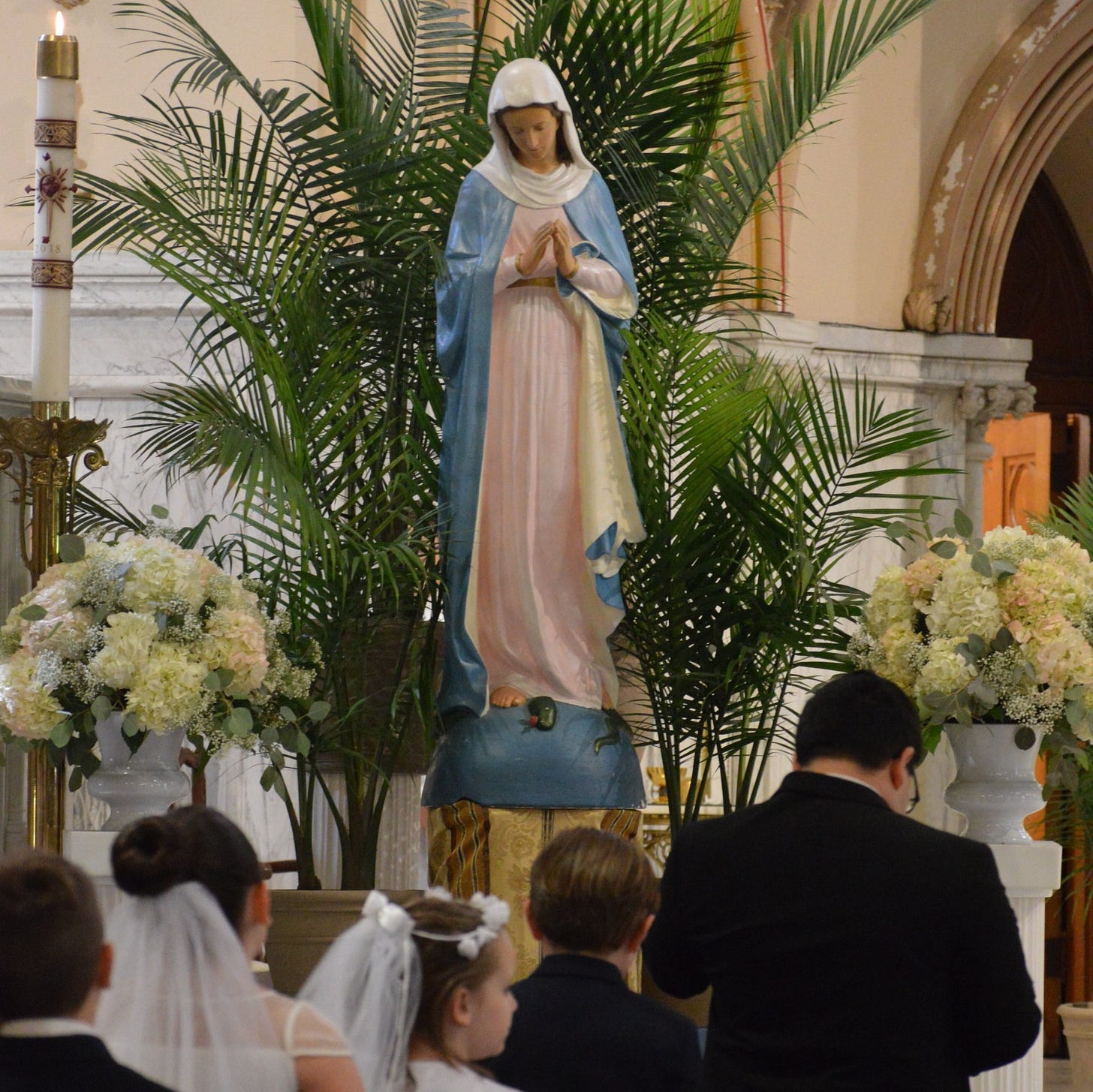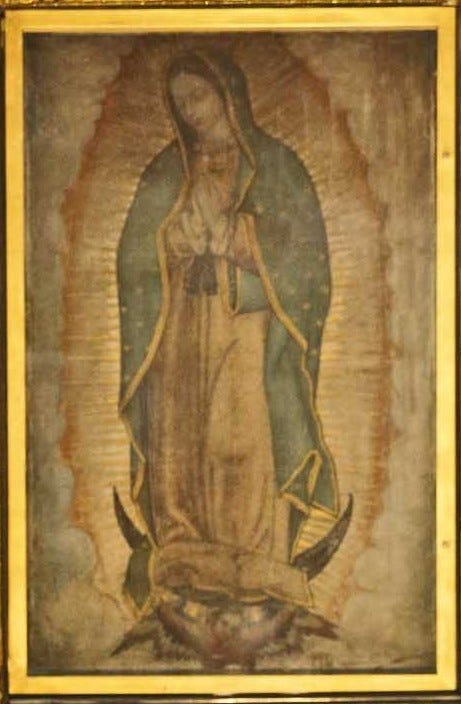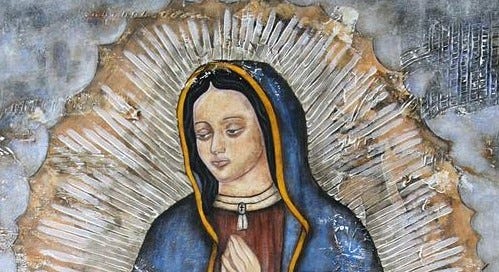Technically, the December 12 Feast of Our Lady of Guadalupe would fall under a Catholic celebration and disqualify it for my December round-up of non-Christian holidays, but that’s not how I think of it. And here’s why. . . .
Believe me, I know my Virgin Mary. She was the model of womanhood for Catholic girls. Every one of us in school wanted to play her in the May Day procession, wear the blue robe, have a flowing white veil held in place with a crown of roses, and carry a bouquet of lily-of-the-valley. At our first holy communion we received a gold Immaculate Conception medal to pin on our white dresses. Around the neighborhood were grottos and shrines, life-size depictions of the Virgin Mary’s appearances in Lourdes and Fatima. We made the sign of the cross as we passed and half hoped she would show up again and make us special.

But the reasons Mary was pressed upon us were the same reasons that made her decidedly unattractive as we grew older. Submissiveness and obedience do not sit well with pre-teens, and the virginal aspect was a deal-breaker by eighth grade. Her many visits seemed possible, yet, while engendering creations of churches and shrines, calls to more closely follow her Son’s teachings and, of course, miracles, none of her commands and purposes were dramatic in the sense that they didn’t bring real change to the world. A “what kind of role model is that?” apathy sunk in by senior year.
Our Lady of Guadalupe, appearing in 1531 to Juan Diego, an Aztec peasant in a village outside of Mexico City, is altogether another matter. One look at her image that was somehow printed on his tilma (cloak) cleaved her from all the other images of Mary. She took the form of an Aztec princess. Her skin was as dark as Diego’s, her long dark hair clearly visible under her veil. Instead of her accustomed white gown, Mary wore a tunic as red as the country’s soil. Her mantel was the distinct blue that only Aztec royalty were allowed to wear. A jasmine flower imprinted on the tunic above her womb was an Aztec symbol meaning the center of the cosmic order. So, too, was the sun emanating around her—the Aztec representation of their greatest god, Huitzilopochtli.

In the midst of these indigenous characteristics, Spanish viewers would have known that the dark ribbon under her breast revealed her pregnancy and that the cross on her medallion around her throat was the same shape seen upon the sails of Spanish ships. Most telling, she stood on a feather bedecked moon, the personification of the Aztec god Quetzalcoatl—the feathered serpent moon god. She was crushing it.
At the time of her appearance, the country was torn apart by the Conquistadors smashing the indigenous tribes and forming a mixed race. Mary’s image was soon taken to be a personal call from the Almighty to unite. Sceptic non-believers may see Our Lady’s story as a very shrewd political marketing tool. The Catholic Church did not shy from employing all kinds of methods to take control of a country and usurp the religious beliefs and practices of native populations and she appeared at a time when Spanish-Mexican and native leaders were striving to align shared interests.
But who is to say if her visit was real or not? It ultimately doesn’t matter when, over the centuries, she increasingly came to be seen as a representation of Mexico’s unique identity. Our Lady of Guadalupe’s lasting impact on every aspect of a country’s consciousness is what separates her from all other Virginal incarnations. Her image evolved into a powerful patriotic symbol used by kings, presidents, rebel forces and, to this day, an insightful instrument for foreign leaders in their political dealings with Mexico. Our Lady of Guadalupe remains such a core presence that she cannot be separated from the country’s spirit.
For all these reasons, the feast day of Our Lady of Guadalupe is a most special day for Mexicans and Latinos around the world. Several fiestas are planned at nearby churches to honor her. There will be a special high mass at noon filled with songs and flowers arranged everywhere and a gathering in the church hall afterwards. A flyer at a small restaurant down the street listed the details of one church’s event: a community lunch provided by the parishioners, musical entertainment, and a charity auction, tickets $1 apiece. Proof of vaccination and/or masks are required; sweaters suggested as a tent will be erected in the playground for those who wish to remain outdoor.
The flyer also asks that the parishioners let the church know what dishes they’re bringing ahead of time to be certain there is enough for everyone. The people who have settled here are predominantly from Puebla, Oaxaca, and Campeche, home states for some of the most exquisite dishes in Mexican cuisine. Among the suggested dishes of tamales, quesadillas, and tortas, there was a particular call for moles and something called shark bread. And, of course, Christmas cookies, the recipe for which you’ll find in yesterday’s post.
THANKS FOR READING TODAY’S STORY! IN APPRECIATION TO AMERICA EATS! SUBSCRIBERS, HEAD OVER TO MY WEBSITE TO RECEIVE YOUR COPY OF THE NEWSLETTER’S FIRST PRINTED BOOKLET, “SOUTHERN COOKING,” BY THE GREAT AMERICAN FICTION WRITER, EUDORA WELTY. TYPE IN YOUR MAILING ADDRESS AND I’LL SEND IT TO YOU RIGHT AWAY. IT ALSO MAKES A GREAT GIFT!


